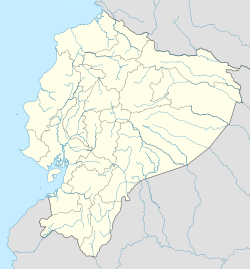This article needs additional citations for verification. (August 2011) |
Zaruma | |
|---|---|
Town | |
| Villa Real De San Antonio del Cerro de Oro de Zaruma | |
| Nickname: Sultana de El Oro | |
Location of Zaruma within Ecuador | |
| Coordinates: 03°41′00″S 79°36′00″W / 3.68333°S 79.60000°W | |
| Country | Ecuador |
| Province | El Oro Province |
| Canton | Zaruma Canton |
| Foundation | December 8, 1595 |
| Founded by | Damian Meneses |
| Named for | zara and huma |
| Government | |
| • Type | Mayor and council |
| • Mayor | Carlos Aguilar |
| Area | |
• Town | 2.6 km2 (1.0 sq mi) |
| Elevation | 1,200 m (3,900 ft) |
| Population (2022 census)[1] | |
• Town | 10,005 |
| • Density | 3,800/km2 (10,000/sq mi) |
| Demonym | Zarumeño(-a) |
| Time zone | UTC-5 (ECT) |
| Postal code | EC071150 (new format) |
| Area code(s) | (0)72972, (0)72973 |
| Website | http://www.zaruma.gob.ec |
Zaruma, officially Villa Real de San Antonio del Cerro de Oro de Zaruma is a town in the south of Ecuador, El Oro Province. It is located in the south-east of this province, at an altitude of 1200 metres above sea level, on an inter-Andes route where the Vizcaya mountain range branches off from the Chilla mountain range. It is the seat of Zaruma Canton, one of the oldest cantons in the province.
Zaruma is known for its republic-era architecture, gold mines, culture and traditions, art and coffee and for having been founded by Spanish explorer Alonso de Mercadillo. These attributes have led to its receiving various titles celebrating both its tangible and intangible aspects, and in 1998 the Ecuadorian Institute for Cultural Heritage submitted it as a candidate UNESCO World Heritage Site.
Zaruma was named a Pueblo Mágico (magical town) by the Ecuadorian Ministry of Tourism (MINTUR) in 2019. It is one of five communities across the country that inaugurated the programme that year.[2]

- ^ Citypopulation.de
- ^ "Zaruma declarada Pueblo Mágico de Ecuador – Ministerio de Turismo" (in Spanish). Retrieved 2021-04-02.


